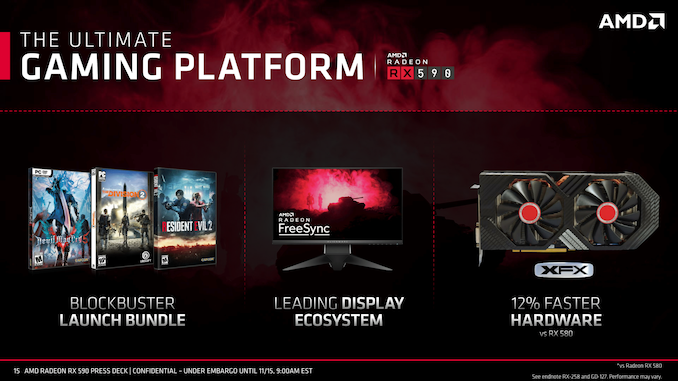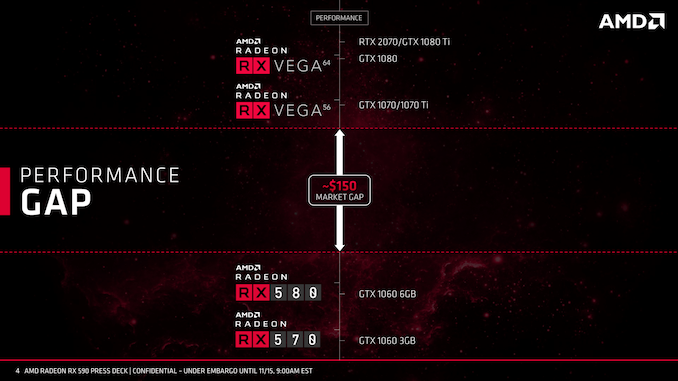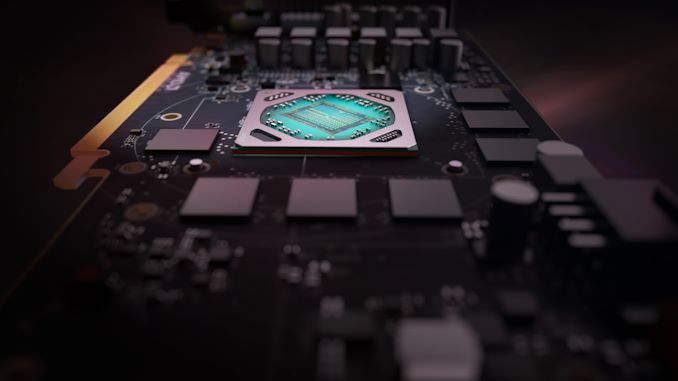The AMD Radeon RX 590 Review, feat. XFX & PowerColor: Polaris Returns (Again)
by Nate Oh on November 15, 2018 9:00 AM ESTClosing Thoughts
As we bring this to a close, the Radeon RX 590 features few, if any, surprises, indeed outperforming the RX 580 via higher clockspeeds but at the cost of additional power consumption. This is enabled by being fabbed on 12nm and being afforded higher TBPs, but in terms of overall effect, the port to 12nm is less of a die shrink and more of a new stepping; in terms of transistor count and die size Polaris 30 is identical to Polaris 10. Feature-wise, whereas the RX 500 series did introduce a new mid-power memory state, the RX 590 doesn't add anything.
Altogether, AMD is helping push the RX 590 along with a three-game launch bundle and emphasizing the value of FreeSync monitors. One might add that the RX 590 also makes the most out of the game bundle, which now presents itself as a direct value-add for the card. But the card by itself isn't providing more bang for your buck than with the RX 580.
By the numbers, then, where does the RX 590 land? Reference-to-reference, the RX 590 is about 12% faster than the RX 580 at 1080p/1440p, and 14-15% faster than the RX 480. Across the aisle, this turns out to be 9% faster than the reference GTX 1060 6GB, though the GeForce card still takes the lead in games like GTA V and Total War: Warhammer II. That matchup itself is more-or-less an indicator of how far Polaris has come - the RX 480 at launch was 11% behind the GTX 1060 6GB, and the RX 580 at launch was 7% behind. Improvements have come over the years with drivers and such, where the RX 480 and RX 580 are much closer, but the third time around, Polaris can finally claim the victory at launch.
That being said, the 9% margin is well within reach of factory-overclocked GTX 1060 6GB cards, especially with a 9Gbps option that the RX 590 doesn't have. Even with the XFX Radeon RX 590 Fatboy the delta only increases to about 11%. In other words, as custom factory-overclocked cards the RX 590 and GTX 1060 6GB are likely to trade blows. And heavily factory-overclocked RX 580s are in the similar situation.
But similar to the RX 580 and 570, the RX 590 achieves this at the cost of even more power consumption. In practical situations like in Battlefield 1, the RX 590 results in the system pulling around 110W more from the wall than with the GTX 1060 6GB. The RX 590 is not a power efficient card at the intended clocks and TBP, and so won't be suitable for SFF builds or reducing air conditioning usage.
Once again though, we've observed that VRAM is never enough. It was only a few years ago that 8GB of VRAM was considered excessive, only useful for 4K. But especially with the popularity of HD texture packs, even 6GB of framebuffer could prove limiting at 1080p with graphically demanding games. In that respect, the RX 590's 8GB keeps it covered but also brings additional horsepower over the 8GB R9 390. For memoryhogging games like Shadow of War, Wolfenstein II, or now Far Cry 5 (with HD textures), the 8GBs go a long way. Even at 1080p, GTX 980/970 performance in Wolfenstein II tanks because of the lack of framebuffer. For those looking to upgrade from 2GB or 4GB cards, both the RX 580 and RX 590 should be of interest.
So in terms of a performance gap, the custom RX 590s seem poised to fill in, though it might be in the range of 5 to 10% when comparing to existing heavily factory-overclocked RX 580s. That gap, of course, would likely have been filled by a 'Vega 11' product, which never came to fruition. Beyond a smaller discrete Vega GPU, 12nm Vega seems less likely given that 14nm+ Vega is no longer on the roadmap. And with 7nm Vega announced as Radeon Instinct MI60 and MI50 accelerators, there's no current indication of those GPUs coming into the consumer space. We also know very little about Navi other than being fabbed with TSMC on 7nm and due in 2019.
So of the possible cards in AMD’s deck, we are seeing a single 12nm Polaris SKU slotting in above the existing RX 580. If there are no further refreshes coming, then gamers will naturally ask when Polaris will be replaced as AMD's mainstream offering, as otherwise the RX 500 series will be holding the fort until then. If this is a prelude to further refreshes, then it becomes a question of how much more performance can be squeezed from Polaris.
The bigger picture is that from the consumer point-of-view, RX Vega in August 2017 was the most recent video card launch before today. There are more pressing concerns in the present: NVIDIA's recently-launched Turing-based GeForce RTX 20 series, as well as Intel's renewed ambition for discrete graphics and subsequent graphics talent leaving AMD for Intel. While the RX 590 avoids the optics of having no hardware response whatsoever in the wake of the RTX 20 cards, it is still a critical juncture with respect to DirextX Raytracing (DXR) development. And regardless, Intel has announced 2020 as the date for their modern discrete GPUs.
So as we head into 2019, it will be a crucial year for AMD and RTG. But returning to the Radeon RX 590, it applies pressure to the GTX 1060 6GB and older GTX 900 series cards, while avoiding direct pressure on existing RX 580 inventory by virtue of pricing. And right now, without anything to compete with the GTX 1080 Ti/RTX 2070 range or above, AMD is likely more than happy to take any advantage where they can. For now, though, much depends on the pricing of top-end RX 580s.













136 Comments
View All Comments
AMD#1 - Tuesday, November 20, 2018 - link
Well, they released a card this year for the consumer market. My hopes are that Navi will be a better option against NVIDIA RTX, good that Radeon will not support RT. Let NVIDIA first support DX12 with hardware shader units, instead of hanging on to DYING DX11.silverblue - Wednesday, November 21, 2018 - link
A couple of reviews seem to be showing the Fatboy at similar power consumption (or slightly higher) levels to the 580 Nitro+ (presumably the 1450MHz version) and Red Devil Golden Sample. That's not so bad when you factor in the significantly increased clocks, but the two 580s hardly sipped power to begin with, and basic 580s don't really perform much worse for what would be much lower power consumption. AMD has a product that kind of bridges the gap between the 1060 and the 1070, but uses more power than a 1080... hardly envious, really. The Fatboy has rather poor thermals as well if you don't ramp the fan speed up.The 590s we're getting are clocked aggressively on core but not on memory; what would really be interesting is a 590 clocked at 580 levels, even factory overclocked 580 levels. Would it be worth getting a 590 just to undervolt and underclock the core, make use of the extra game in the bundle (once they launch, that is), and essentially be running a more efficient 580? I'd be tempted to overclock the memory at the same time as that appears to be where the 580 is being held back, not core speed.
silverblue - Wednesday, November 21, 2018 - link
I'll be fair to the Fatboy; it does have a zero RPM mode which would explain the thermals.WaltC - Sunday, December 2, 2018 - link
I just bought a Fatboy...to run in X-fire with my year-old 8GB RX-480 (1.305GHz stock)...! As I am now gaming at 3840x2160, it seemed a worthwhile alternative to dropping $500+ on a single GPU. Paid $297 @ NewEgg & got the 3-game bundle. I read one review by a guy who X-fired a 580 with a 480 without difficulty--and the performance scaled from 70%-90% better when X-Fire is supported. Wouldn't recommend buying two 590's at one time, of course, but for people who already own a 480/580, the X-Fire alternative is the most cost-effective route at present. Gaming sites seem to have forgotten about X-Fire these days, for some reason. Of course, the nVidia 1060 doesn't allow for SLI--so that might be one reason, I suppose. Still, it's kind of baffling as the X-Fire mode seems like such a no brainer. And for those titles that will not X-fire, I'll just run them all @ 1.6GHz on the 590...Until next year when AMD's next < $300 GPU launches...! Then, I may have to think again!quadibloc - Friday, December 7, 2018 - link
Oh, so Global Foundries does now have a 12 nm process? I'm glad they're doing something a little better than 14 nm at least.